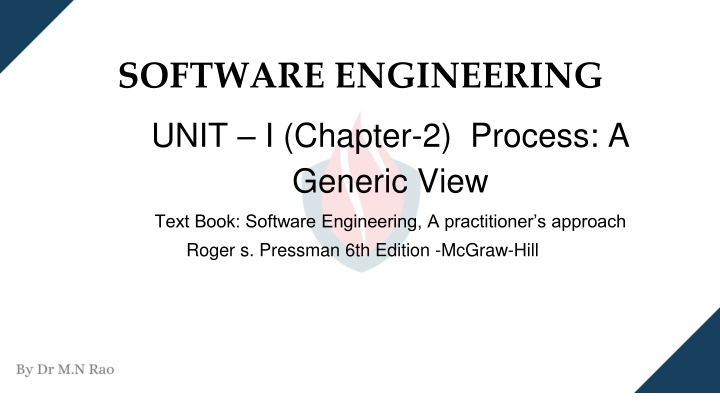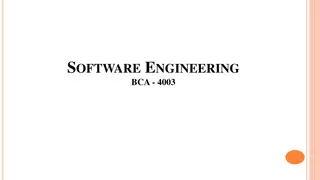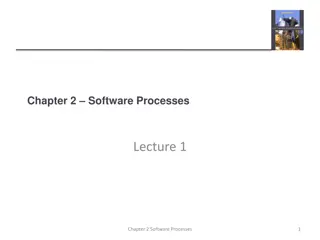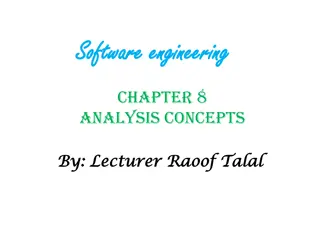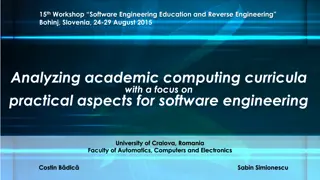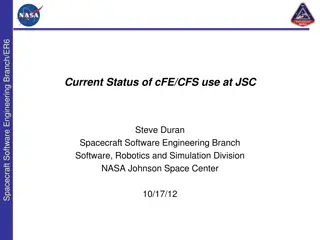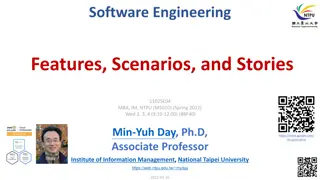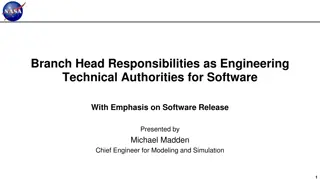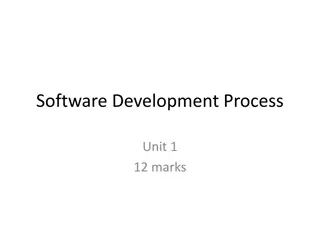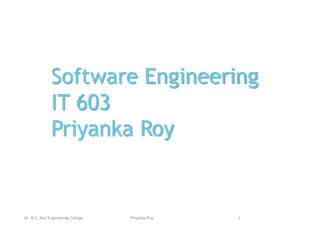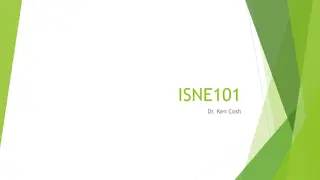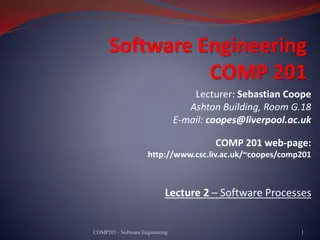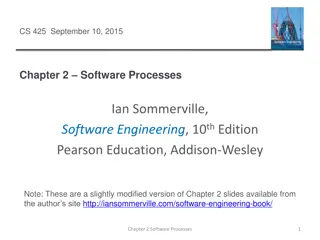Software Engineering: A Comprehensive Overview of Processes and Frameworks
Software engineering involves applying systematic and disciplined approaches to develop, operate, and maintain software efficiently. It utilizes layered technology and framework activities such as communication, planning, modeling, design, testing, and deployment. The field has evolved to encompass various software types like web applications, artificial intelligence, and cloud computing, necessitating umbrella activities for project tracking, risk management, quality assurance, and more. Additionally, the Capability Maturity Model Integration (CMMI) offers models for assessing process areas against specific goals in software development.
Download Presentation

Please find below an Image/Link to download the presentation.
The content on the website is provided AS IS for your information and personal use only. It may not be sold, licensed, or shared on other websites without obtaining consent from the author.If you encounter any issues during the download, it is possible that the publisher has removed the file from their server.
You are allowed to download the files provided on this website for personal or commercial use, subject to the condition that they are used lawfully. All files are the property of their respective owners.
The content on the website is provided AS IS for your information and personal use only. It may not be sold, licensed, or shared on other websites without obtaining consent from the author.
E N D
Presentation Transcript
SOFTWARE ENGINEERING UNIT I (Chapter-2) Process: A Generic View Text Book: Software Engineering, A practitioner s approach Roger s. Pressman 6th Edition -McGraw-Hill
Outline Software Engineering A Layered Technology Software Process Framework Framework Activities Umbrella Activities Capability Maturity Model Integration (CMMI) Process Patterns Personal Software Process (PSP)
Software Enginnering Software Engineering is the establishment and use of sound engineering principles in order to obtain economically software that is reliable and works efficiently on real machines. The IEEE definition: Software Engineering The application of a systematic, disciplined, quantifiable approach to the development, operation and maintenance of software; that is, the application of engineering to software.
Framework Activities Communication Involves communication and collaboration with the customer(Stakeholder) Planning Technical Tasks, Risks, Resources, work Products to be produced and work schedule Modeling Analysis of Requirements Design Construction Code generation Testing Deployment
Changing Nature of Software System software Application software Engineering/scientific software Embedded software Product-line software Web-applications Artificial Intelligence software Netsourcing Open source Also Data mining Cloud Computing Software for nanotechnologies
Umbrella Activities Software Project Tracking and Control Risk Management Software Quality Assurance Formal Technical Reviews Software Configuration Management Reusability Management Measurement Work product preparation and production
Capability Maturity Model Integration (CMMI) Two different Models Continuous Model Staged Model Continuous Model Two-dimensional Each Process Area is assessed against Specific Goals and the Specific Practices required to achieve these goals. Defines a set of Generic Goals and Generic Practices for each Process Area Ex: Project Planning
Continuous Model Capability Levels Level 0: Incomplete Level 1: Performed Level 2: Managed Organizational Policy Level 3: Defined Standards (Work Products) Level 4: Quantitatively managed Level 5: Optimized
Process Areas Required to achieve Maturity Level Level Focus Process Area Performed Managed Basic Project Management Requirement Project Process Configuration Management Management & Project Planning Analysis Assurance Monitoring Control Product Measurement Quality & & Defined Process standardization Verification & Validation Organizational Process Focus Organizational Training Risk Management Integrated Teaming Quantitatively Managed Quantitative Management Organizational Process Performance Quantitative Project Management Optimizing Continuous Process Improvement Organizational Causal Analysis & Resolution. Innovation & Development
Process Patterns Process patterns define a set of activities, actions, work tasks, work products and related behaviors required to develop computer software. Process Pattern provides a Template Pattern Name - Ex: Customer Communication Intent - Objective Type Task Patterns - Ex: Requirements Gathering Stage Patterns Ex: Communication Phase Patterns Ex: Spiral Model Initial Context Problem Solution Resulting Context Related Patterns Known Uses/Examples
Process Assessment The process should be assessed to ensure that it meets a set of basic process criteria that have been shown to be essential for a successful software engineering. Many different assessment options are available: SCAMPI Standard CMMI Assessment Method for Process Improvement CBA IPI CMM-Based Appraisal for Internal Process Improvement ISO 9001:2000 for software Plan Do Check - Act
Personal Software Process (PSP) Recommends five framework activities: 1. Planning 2. High-level design 3. High-level design review 4. Development 5. Postmortem stresses the need for each software engineer to identify errors early and as important to understand the types of errors
Team Software Process (TSP) Each project is launched using a script that defines the tasks to be accomplished Teams are self-directed Measurement is encouraged Measures are analyzed with the intent of improving the team process 1. Launch 2. High-level design 3. Implementation 4. Integration 5. Test 6. Postmortem
Process, Product & Project Set of steps to be followed to develop a product is called Software Process The execution of specificuser needs is a Software Project Outcome of software process is called Product activities for some
Process, Product & Project Set of steps to be followed to develop a product is called Software Process The execution of specificuser needs is a Software Project Outcome of software process is called Product activities for some
